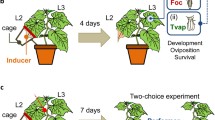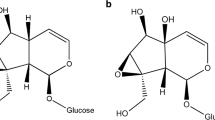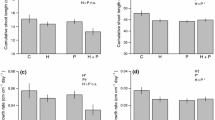Summary
Insect herbivores that require young foliage for successful larval development are often restricted to a single generation during a year by the scarcity of suitable food over most of the growing season. The major specialist herbivore attacking shrubs in the genus Asimina in Florida, Eurytides marcellus, requires young foliage for successful larval development. Field manipulations were used to investigate the role of the young foliage produced by Asimina in response to defoliation by the late-season feeder Omphalocera munroei, a second specialist herbivore of Asimina in Florida, in maintaining Eurytides populations during the summer months when young foliage is otherwise scarce. Defoliation by Omphalocera proved to be the major inducer of young growth during the summer because Omphalocera defoliated Asimina shrubs so frequently and severely. When compared to young leaves produced in the absence of damage, the teaves produced by Asimina in response to defoliation were equally as suitable as food for Eurytides larvae and as acceptable as oviposition sites by Eurytides females. The availability of young foliage in an Asimina population was correlated with the size of the associated Eurytides population. The combination of regular, severe defoliation by Omphalocera and lack of a defensive response to damage by Asimina lead to a positive affect of Omphalocera on Eurytides population size, and may be central to other facilitative interactions between herbivores as well.
Similar content being viewed by others
References
Auerbach M, Simberloff D (1984) Responses of leaf miners to atypical leaf production patterns. Ecol Entomol 9:361–376
Carroll CR, Hoffman CA (1980) Chemical feeding deterrent mobilized in response to insect herbivory and counteradaptation by Epilachna tridecemnotata. Science 209:414–416
Christensen NL (1981) Fire regimes in southeastern ecosystems. In: Mooney HA, Bonnicksen TM, Christensen NL, Lotan JE, Reiners WA (eds) Fire regimes and ecosystem properties. U S Forest Serv Tech Rep WO-26, pp 112–136
Cole LC (1954) The population consequences of life history phenomena. Quart Rev Biol 29:103–137
Coley PD (1983) Herbivory and defensive characteristics of tree species in a lowland tropical forest. Ecol Monogr 53:209–233
Crawley MJ, Nachapong M (1984) Facultative defenses and specialist herbivores? Cinnabar moth (Tyria jacobaeae) on the regrowth foliage of ragwort (Senecio jacobaea). Ecol Entomol 9:389–393
Damman H (1986a) The osmaterial glands of the swallowtail butterfly Eurytides marcellus as a defence against natural enemies. Ecol Entomol 11:261–265
Damman H (1986b) Effects of seasonal changes in leaf quality and abundance of natural enemies on the insect herbivores of pawpaws. Ph D Thesis, Cornell University
Dixon AFG (1970) Quality and availability of food for a sycamore aphid population. In: Watson A (ed) Animal populations in relation to their food resources. Blackwell Scientific, Oxford, pp 271–282
Faeth SH (1986) Indirect interactions between temporally separated herbivores mediated by the host plant. Ecology 67:479–494
Faeth SH, Mopper S, Simberloff D (1981) Abundances and diversity of leaf-mining insects on three oak host species: effects of host-plant phenology and nitrogen content of leaves. Oikos 37:238–251
Feeny P (1970) Seasonal changes in oak leaf tannins and nutrients as a cause of spring feeding by winter moth caterpillars. Ecology 51:565–581
Fowler SV, Lawton JH (1985) Rapidly induced defenses and talking trees: the devil's advocate position. Am Nat 126:181–195
Futuyma DJ, Wasserman SS (1980) Resource concentration and herbivory in oak forests. Science 201:920–922
Hairston NG, Smith FE, Slobodkin LB (1960) Community structure, population control, and competition. Am Nat 94:421–425
Harrison S, Karban R (1986) Effects of an early-season folivorous moth on the success of a late-season species, mediated by a change in the quality of the shared host, Lupinus arboreus Sims. Oecologia 69:354–359
Haukioja E, Niemelä P (1979) Birch leaves as a resource for herbivores: seasonal occurrence of increased resistance in foliage after mechanical damage of adjacent leaves. Oecologia 39:151–159
Heichel GH, Turner NC (1976) Phenology and leaf growth of defoliated hardwood trees. In: Anderson JF, Kaya HK (eds) Perspectives in forest entomology. Academic Press, New York, pp 31–40
Heinrich B (1979) Foraging strategies of caterpillars. Oecologia 42:325–337
Hodson AC (1981) The response of aspen (Populus tremuloides) to artificial defoliation. Great Lakes Entomol 14:167–169
Hough JA, Pimentel D (1978) Influences of host foliage on development, survival, and fecundity of the gypsy moth. Environ Entomol 7:97–102
Jones EW (1959) Biological flora of the British Isles: Quercus L. J Ecol 47:169–222
Kalisz PJ, Stone EL (1984) The longleaf pine islands of the Ocala National Forest, Florida: a soil study. Ecology 65:1743–1754
Kral R (1960) A revision of Asimina and Deeringothamnus (Annonaceae). Brittonia 12:233–278
Lawton JH, Strong DR (1981) Community patterns and competition in folivorous insects. Am Nat 118:317–338
Lowman MD (1982a) Effects of different rates and methods of leaf area removal on rain forest seedlings of coachwood (Ceratopetalum apetalum). Austral J Bot 30:477–483
Lowman MD (1982b) Seasonal variation in insect abundance among three Australian rain forests, with particular reference to phytophagous types. Austral J Ecol 7:353–361
Macauley BJ, Fox LR (1980) Variation in total phenols and condensed tannins in Eucalyptus: leaf phenology and insect grazing. Austral J Zool 5:31–35
Nagy M (1979) The effect of Lepidoptera larvae consumption on the leaf production of Quercus petraea (Matt.) Liebl. Acta Bot Acad Sci Hungaricae 27:141–150
Niemelä P, Haukioja E (1982) Seasonal patterns in species richness of herbivores: macrolepidoptera larvae on Finnish deciduous trees. Ecol Entomol 7:169–175
Opler PA (1974) Biology, ecology, and host specificity of Microlepidoptera associated with Quercus agrifolia (Fagaceae). Univ Calif Publ Entomol 75:1–83
Rathcke B (1983) Competition and facilitation among plants for pollination. In: Real L (ed) Pollination biology. Academic Press, New York, pp 305–329
Rausher MD (1981) Host plant selection by Battus philenor butterflies: the roles of predation, nutrition, and plant chemistry. Ecol Monogr 51:1–20
Reichle DE, Goldstein RA, Van Hook RI, Dodson GJ (1973) Analysis of food consumption in a forest canopy. Ecology 54:1076–1084
Rhoades DF (1985) Offensive-defensive interactions between herbivores and plants: their relevance in herbivore population dynamics and ecological theory. Am Nat 125:205–238
Rockwood LL (1974) Seasonal changes in the susceptibility of Crescentia alata leaves to the flea beetle, Oedionychus sp. Ecology 55:142–148
Schoener TW (1983) Field experiments on interspecific competition. Am Nat 122:240–285
Sokal RR, Rohlf FJ (1981) Biometry. WH Freeman & Company, San Francisco
South R (1961) The Moths of the British Isles. Frederick Warne & Co, Ltd
Springett BP (1978) On the ecological role of insects in Australian eucalypt forests. Austral J Ecol 3:129–139
Stearns SC (1976) Life history tactics: a review of the ideas. Quart Rev Biol 51:3–47
Washburn JO, Cornell HV (1981) Parasitoids, patches, and phenology: their possible role in the local extinction of a cynipid gall wasp population. Ecology 62:1597–1607
Watanabe M (1981) Population dynamics of the swallowtail butterfly, Papilio xuthus L., in a deforested area. Res Popul Ecol 23:74–93
Watanabe M (1982) Leaf structure of Zanthoxylum ailanthoides Sieb et Zucc. (Rutales: Rutaceae) affecting the mortality of a swallowtail butterfly, Papilio xuthus L. (Lepidoptera: Papilionidae). Appl Ent Zool 17:151–159
Webber HJ (1935) The Florida scrub, a fire-fighting association. Am J Bot 22:344–361
West C (1985) Factors underlying the late seasonal appearance of the lepidopteran leaf-mining guild on oak. Ecol Entomol 10:111–120
Williams KS, Myers JH (1984) Previous herbivore attack of red alder may improve food quality for fall webworm larvae. Oecologia 63:166–170
Wolda H (1978) Seasonal fluctuations in rainfall, food and abundance for tropical insects. J Anim Ecol 47:369–381
Author information
Authors and Affiliations
Rights and permissions
About this article
Cite this article
Damman, H. Facilitative interactions between two lepidopteran herbivores of Asimina . Oecologia 78, 214–219 (1989). https://doi.org/10.1007/BF00377158
Received:
Issue Date:
DOI: https://doi.org/10.1007/BF00377158




